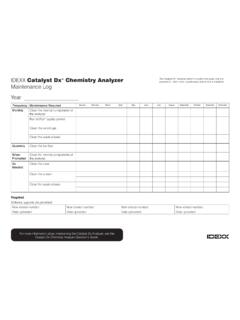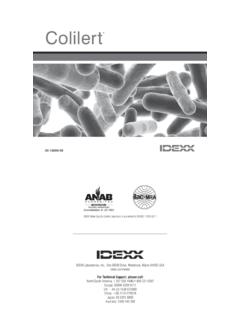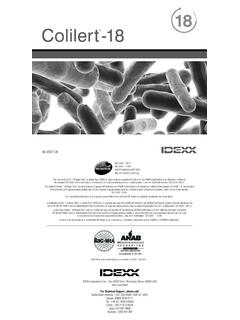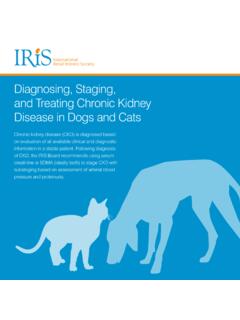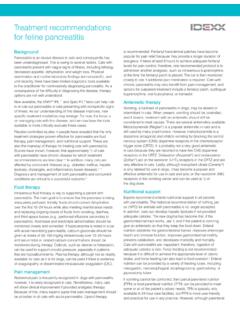Transcription of Diagnosis and management of bacterial urinary tract ...
1 IntroductionClinical signs associated with lower urinary tract inflammation (inappropriate urination, dysuria, increased frequency) are common presenting complaints in small animal practice. These signs are most likely attributed to bacterial urinary tract infections in dogs and to sterile inflammatory conditions ( , feline idiopathic cystitis [FIC], urolithiasis) or behavioral disorders in cats. bacterial urinary tract infections (UTIs) occur in approximately 14% of dogs in their lifetime,1 with increased prevalence noted in older In cats less than 10 years of age, bacterial UTI is uncommon, affecting only 1% 8% of this 5 UTI is seen more often in older cats and in cats with chronic kidney disease (CKD)
2 Or a history of urinary tract 9 Upper urinary tract infection, or pyelonephritis, is less prevalent in companion animals, but it is clinically important because of the potential sequelae for significant kidney damage and both acute kidney injury and chronic kidney treatment of UTI begins with an accurate Diagnosis of infection. An antibiotic regimen should be chosen that is appropriate to treat both the bacteria identified and the patient that has been clinically assessed for preexisting complicating factors or conditions. Patients with signs of lower urinary tract disease or otherwise suspected of UTI should have a complete urinalysis (UA) performed on a fresh urine specimen, with emphasis on a detailed microscopic urine sediment examination.
3 The urine specimen should be collected aseptically by cystocentesis. A quantitative urine culture with minimum inhibitory concentration (MIC) antibiotic susceptibility testing is recommended to confirm bacteriuria identified on UA and to guide antibiotic selection. This is especially important for patients with complicated UTIs. Most UTIs are the result of ascending bacteria from rectal or fecal contamination or from the distal urogenital tract . A single species of Gram-negative bacteria is cultured from most UTIs, typically E. coli, with Gram-positive Staphylococcus, Streptococcus, and Enterococcus infections and mixed- bacterial infections reported less ,11 Familiarity with the most common urinary pathogens, along with bacterial morphology identified by urine sediment examination may help to guide initial treatment while culture results are pending.
4 Effective April 2017, in addition to reporting presence of rare, moderate or marked bacteria, IDEXX Reference Laboratories will report the morphology (rods, cocci) of any bacteria present on your urinalysis results. Predisposing factors for bacterial UTIIn dogs, predisposing factors for bacterial UTI include, but are not limited to, gender (being a spayed female); anatomic or functional changes that influence continence or complete emptying of the bladder, such as ectopic ureters12 and posterior paresis13; systemic diseases, such as diabetes mellitus, hyperadrenocorticism,14 and hyperparathyroidism15.
5 Or the use of medications such as UTIs are common in cats with concurrent chronic kidney disease, diabetes mellitus, and ,18 Clinical signsThe clinical signs seen with UTI vary depending on the part of the urinary tract affected. Infections of the upper urinary tract (pyelonephritis) that involve the kidney and adjacent ureters may result in systemic signs of illness, including fever, depression, anorexia and vomiting, and flank or renal pain. Localized infections of the lower urinary tract are recognized more commonly with bladder infection causing cystitis, which is often combined with urethral infection, or signs of lower urinary tract infection include frequent voiding of urine (pollakiuria) with dysuria, marked by urgency and straining (stranguria), as well as urinary accidents or urinating in inappropriate places (periuria; , outside the litter box).
6 Affected animals may urinate cloudy or grossly bloody urine (hematuria) that is sometimes malodorous. They may lick at the urogenital area, cry or vocalize, or develop urinary incontinence. In contrast to upper urinary tract infection, systemic signs of illness are not expected with lower urinary tract Clinical signs of UTI may be subtle or are unrecognizable in some patients that have an infection confirmed by urine , simple, and complicated urinary tract infectionsDetermining the clinical significance of confirmed bacteriuria in a patient without clinical signs of UTI, , with asymptomatic bacteriuria19 or subclinical bacteriuria, should include a thorough consideration of all patient factors and information about the potential for pathogenicity of the bacteria.
7 22 Veterinarians may tend toward overdiagnosis to avoid missing UTI with subtle clinical signs, but treatment may not always be indicated for subclinical Consultation with a veterinary internist or microbiologist may be helpful in determining whether treatment could be warranted in a patient not exhibiting clinical signs of a UTI. For patients with clinical signs, UTI management may differ depending on whether the infection is a simple, uncomplicated UTI or a complicated UTI. Simple UTIs are sporadic or infrequent bladder infections (typically no more often than two to three times a year) diagnosed in a female or neutered male dog that is otherwise healthy and has normal urinary anatomy and ,23 This patient group is often successfully treated with first-line antibiotics without guidance from a urine culture.
8 Complicated UTIs include infections in patients with concurrent predisposing condition(s), as well as infections in cats and intact male Diagnosis and effective management of complicated UTI generally requires both a complete urinalysis and quantitative culture and susceptibility testing. When possible, predisposing cause(s) should be determined concurrently with a comprehensive workup that includes a complete CBC and biochemistry with electrolytes and the IDEXX SDMA Test, and may also include advanced imaging of the urinary tract . Endocrine function testing Diagnosis and management of bacterial urinary tract infections in dogs and catsDiagnostic update April 2017or other diagnostics may be necessary.
9 Treating or correcting the underlying cause(s) where possible is also needed to increase the chances of microbial cure. Monitoring the success of treatment of complicated UTIs is another routine indication for urine culture. Recurrent infections are complicated UTIs. Urine culture results are needed to differentiate between persistent or relapsing infections with the same organism and reinfections that are associated with a different microorganism than was previously Diagnostic workup for patients with recurrent UTIs may be similar, but management is typically quite different for patients with persistent infections versus new infections.
10 Patient advocacy and responsible stewardship of antibiotic use should motivate veterinary professionals to understand the success of antimicrobial treatment and to investigate the reasons for any apparent failure of treatment. The use of culture and sensitivity testing results to carefully guide antibiotic usage is one strategy to limit the antimicrobial resistance problem that exists of urinary tract infectionsA complete urinalysis, consisting of physical and chemical evaluations, and microscopic examination of an unstained, wet urine preparation may suggest a probable Diagnosis of UTI, facilitating timely treatment of a painful and possibly life-threatening condition.
